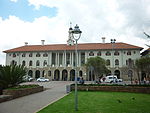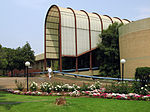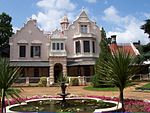Pretoria Central Prison
Pretoria Central Prison, renamed Kgosi Mampuru II Management Area by former President Jacob Zuma on 13 April 2013 and sometimes referred to as Kgosi Mampuru II Correctional Services is a large prison in central Pretoria, within the City of Tshwane in South Africa. It is operated by the South African Department of Correctional Services. The complex comprises six correctional centres, including the notorious C Max, Pretoria Local Prison, and a women's prison. The new name is the same as the street name (renamed in the previous year), with both now bearing the name of Kgosi Mampuru, a 19th-century local chief who resisted colonial rule and was subsequently hanged in 1883.
Excerpt from the Wikipedia article Pretoria Central Prison (License: CC BY-SA 3.0, Authors).Pretoria Central Prison
Klawer Street, Pretoria Salvokop
Geographical coordinates (GPS) Address Nearby Places Show on map
Geographical coordinates (GPS)
| Latitude | Longitude |
|---|---|
| N -25.7612 ° | E 28.1816 ° |
Address
Pretoria Central Prison
Klawer Street
0126 Pretoria, Salvokop
Gauteng, South Africa
Open on Google Maps







